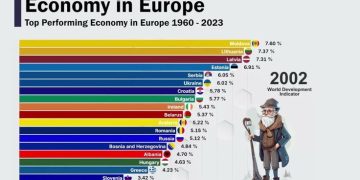Emerging Markets in Asia-Pacific: Navigating Global Monetary Shifts and Regional Opportunities
Introduction: The New Frontier of Global Finance
Emerging markets (EMs) in the Asia-Pacific region have become critical drivers of global economic growth. Countries like Indonesia, Vietnam, the Philippines, Thailand, and Malaysia are balancing domestic development imperatives with global financial volatility. Post-pandemic recovery, supply chain restructuring, and global interest rate shifts have created a highly dynamic environment for these markets.
This article examines the current financial trends in Asia-Pacific EMs, focusing on:
- Monetary policy adaptation to global shifts
- Capital flows, foreign investment, and debt management
- Currency volatility and risk management
- Regional integration and trade dynamics
- Digital finance adoption and innovation
By analyzing these factors, we can understand how EMs in Asia-Pacific navigate complex global financial conditions while capitalizing on regional opportunities.
1. Global Monetary Shifts and Their Impact on Asia-Pacific EMs
1.1 US Federal Reserve and Global Interest Rates
The US Federal Reserve’s post-pandemic tightening cycle has created ripple effects:
- higher yields attract capital away from EMs
- increased debt servicing costs for countries with USD-denominated debt
- pressure on local currencies and inflation dynamics
Asia-Pacific EMs must calibrate monetary policy carefully to balance growth, inflation, and currency stability.
1.2 Divergent Monetary Strategies in EMs
Countries respond differently:
- Indonesia: moderate rate hikes to control inflation without stifling growth
- Vietnam: cautious tightening while maintaining export competitiveness
- Philippines: active inflation targeting, forex interventions
- Thailand & Malaysia: flexible policy to support tourism recovery and fiscal sustainability
Divergence reflects domestic priorities and vulnerability to global capital flows.
2. Capital Flows and Foreign Investment Trends
2.1 Foreign Direct Investment (FDI) Resilience
Asia-Pacific EMs remain attractive for:
- manufacturing relocation (supply chain diversification from China)
- digital economy and fintech investments
- renewable energy and infrastructure projects
FDI inflows are concentrated in Vietnam, Indonesia, and the Philippines, driven by:
- competitive labor costs
- growing domestic consumption
- regional trade agreements (RCEP, CPTPP)
2.2 Portfolio Capital and Volatility
Portfolio investments are more volatile:
- global risk-off events trigger sudden outflows
- currency depreciation amplifies investor caution
- sovereign and corporate bonds face yield adjustments
Countries implement macroprudential policies, including:
- capital flow monitoring
- reserve accumulation
- hedging incentives for foreign investors
2.3 Sovereign Debt and Financing Challenges
EMs often rely on external financing to support growth:
- Indonesia and the Philippines have manageable debt ratios (~40–50% of GDP)
- Vietnam relies on a mix of bilateral loans and bond issuance
- Malaysia maintains moderate fiscal deficits
Rising global interest rates increase debt servicing costs, compelling governments to diversify funding sources and extend maturities.
3. Currency Dynamics and Risk Management
3.1 Exchange Rate Pressures
Asia-Pacific EMs experience FX pressures due to:
- US rate hikes
- global inflation
- commodity price volatility
Countries adopt strategies like:
- flexible exchange rate regimes
- targeted FX interventions
- foreign exchange reserve accumulation
3.2 Hedging and Corporate Strategies
Multinational companies and domestic firms hedge through:
- FX derivatives
- forward contracts
- natural hedging via export-import balance
FX risk management has become central to corporate financial planning.
3.3 Regional Currency Integration
ASEAN initiatives encourage:
- cross-border payments in local currencies
- digital settlement systems
- reduced dependency on USD
While still nascent, this trend enhances resilience against global shocks.
4. Inflation and Monetary Policy
4.1 Post-Pandemic Inflation Drivers
- energy and commodity prices
- supply chain disruptions
- rebounding domestic demand
EM central banks must carefully calibrate interest rates to:
- control inflation expectations
- avoid credit contraction
- support growth
4.2 Inflation Targeting Frameworks
Examples:
- Philippines: explicit 2–4% target with active BOP management
- Indonesia: 3% target with forward guidance
- Thailand: flexible inflation targeting tied to tourism recovery
EMs leverage dynamic monetary policy tools, including repo operations, reserve requirements, and liquidity facilities.
5. Regional Integration and Trade Dynamics
5.1 Trade Realignment Post-Pandemic
Global supply chain restructuring benefits Asia-Pacific EMs:
- manufacturing relocation from China to Vietnam, Indonesia, and Thailand
- export diversification toward ASEAN and Europe
- adoption of regional trade agreements (RCEP, CPTPP)

5.2 Currency and Payment Cooperation
- ASEAN cross-border payment networks (QR interoperability, digital settlements)
- Local currency invoicing to reduce FX risk
- Regional financial coordination through AMRO and ABMI
Integration reduces vulnerability to global capital shocks and enhances intra-regional trade resilience.
6. Digital Finance: Leapfrogging Traditional Systems
6.1 Mobile Payments and Digital Banking
- Philippines: GCash and Maya
- Indonesia: OVO, GoPay
- Vietnam: MoMo and ZaloPay
Digital finance addresses:
- underbanked populations
- microfinance for SMEs
- real-time payment infrastructure
6.2 Fintech Innovation and Investment
- BNPL (Buy Now, Pay Later) adoption
- Digital lending platforms
- Mobile insurance and savings
- SME financing through online platforms
Emerging digital ecosystems increase financial inclusion and domestic consumption.
6.3 Crypto and Tokenized Assets
- Vietnam and the Philippines rank high in crypto adoption
- Digital asset regulations are evolving
- Tokenization of bonds and payments is piloted in Singapore and Indonesia
These innovations position EMs for next-generation finance.
7. Challenges Facing Asia-Pacific EMs
7.1 Global Monetary Pressures
- Fed and ECB policies
- Rising US Treasury yields
- Capital flight risk
7.2 Fiscal Constraints
- Limited room for deficit spending
- Rising debt servicing costs
- Infrastructure financing pressure
7.3 Domestic Structural Risks
- Inflation volatility
- Banking sector vulnerabilities
- Dependence on exports and commodity prices
7.4 Digital Finance Challenges
- Regulatory fragmentation
- Cybersecurity threats
- Financial literacy gaps
8. Opportunities and Strategic Responses
8.1 Supply Chain Realignment
EMs benefit from:
- attracting FDI from China’s industrial relocation
- developing export-oriented manufacturing clusters
- enhancing regional connectivity
8.2 Domestic Market Expansion
- Growing middle-class consumption
- Digital finance drives microcredit, e-commerce, and payments
- Integration with regional super-app ecosystems
8.3 Regional Monetary Cooperation
- Local currency settlements
- Cross-border digital payment systems
- ASEAN financial coordination frameworks
This reduces vulnerability to external shocks and global USD fluctuations.
9. Investor Implications
9.1 Fixed Income Strategies
- Focus on domestic currency bonds with strong credit quality
- Use of hedging instruments to mitigate FX risk
- Tactical exposure to higher-yielding, inflation-adjusted instruments
9.2 Equity Investment
- Tech and digital finance sectors
- Export-oriented manufacturing
- Consumer and service sectors benefiting from urbanization and middle-class growth
9.3 FX and Capital Flow Management
- Hedging strategies essential
- Monitoring global interest rate differentials
- Incorporating risk-adjusted returns in cross-border portfolio allocation
10. Outlook: Asia-Pacific EMs in the Global Financial Landscape
Asia-Pacific emerging markets are navigating a complex post-pandemic financial environment. Key takeaways:
- Monetary adaptation is critical – balancing inflation, growth, and currency stability
- Capital flow management will define resilience – foreign investment and portfolio flows are volatile
- Digital finance adoption accelerates inclusion and growth – mobile-first, fintech-driven economies
- Regional integration strengthens resilience – trade, payments, and currency cooperation mitigate global shocks
- Strategic positioning for supply chain shifts creates long-term advantages
EMs in Asia-Pacific are not merely recovering—they are reshaping the financial architecture of the region, setting a blueprint for emerging markets globally.
Conclusion
The Asia-Pacific emerging markets represent one of the world’s most dynamic financial landscapes. Global monetary shifts, especially rising US rates and diverging policies, have tested these economies, but they are responding with innovative monetary strategies, digital finance adoption, and regional integration initiatives.
By leveraging demographic advantages, digital ecosystems, and trade opportunities, these EMs are transforming challenges into strategic growth opportunities. Their ability to navigate global volatility while fostering domestic stability and regional connectivity will determine Asia-Pacific’s role in the global economy over the next decade.
































